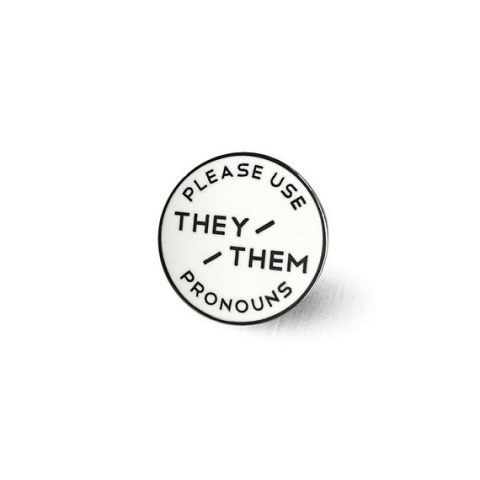Last week, while buying new prescription glasses, the lovely person at the store was wearing this pin. It resulted in a wonderfully honest, open conversation around gender. It was a lovely moment. This pin made it happen. More of this.
100% of profits are donated to Camp Aranu’tiq, a nonprofit program serving transgender & gender-variant youth and their families.

Thank you for linking this!! ❤
Jun 12th, 2018 / 11:09 am
I would be interested in hearing more about the conversation. Should one always use these pronouns? Gender comes up in our school picture business and I think we MUST only use they / them but also one of my children (9yo) who just requested to be called “they” – maybe we should just stop saying he and she altogether? Thanks for always posting interesting things. I would like to post about this subject soon….maybe today and maybe I will post the pin! – Kelsey
Jun 13th, 2018 / 10:43 am
It’s one thing to not feel male or female. It’s quite another to use laws to force people to use 100+ arbitrarily chosen pronouns. Doing that might be enabling someone with a mental illness. It’s not “nice” to do that.
In Canada trans activists have succeeded in getting the laws changed so that it’s a human rights violation which can get you thrown in jail for making a mistake. It’s a disaster. And children can be forcibly taken from their parents and subjected to hormone treatments which sterilize them for life. Not to mention castration.
80% of kids who have gender confusion issues end up being gay when “wait and see” is applied. But this has been framed by activists as “conversion therapy” even though it works. So instead we have made laws to increase the number of a population which has an 80% suicide rate. Really terrible. But that’s because we’re so compassionate.
Jun 13th, 2018 / 9:23 pm
Goodness James, loading us all up with conspiracy theories! I doubt he’ll come back, but just to clarify:
– Mental illnesses can and should be treated like any other illness, but being transgender isn’t a mental illness. Many (but not all) transgender people suffer from dysphoria, but this is treated by validating their identity and transitioning.
– Nobody’s forcing anyone to learn a whole handbook of pronouns, and nobody expects anyone to use the right one when you first meet them. It’s not much different from introducing yourself as and liking to be called “James” and not “Walter” – you can certainly remember that James doesn’t like to be called “Jimbo”, but writes “Jimmy” on his memos.
– People don’t get thrown into jail for making a mistake in Canada.
– Children aren’t put on hormone treatments if they think they might be transgender, they’re put on hormone blockers that only delay changes to their body as they grow. This gives them time to sort things out; it takes a lot of time and evaluations to even get approval to start transitioning, let alone the lengthy transitioning process itself (if a trans person decides to undergo HRT at all – not all do).
– The entire last paragraph seems to be fabricated, but transgender people do have a higher rate of suicide than average, as well as a much higher rate of being harassed, assaulted, and murdered. Human Rights Campaign has some informative resources on this.
Jun 15th, 2018 / 11:43 am
We are finally approaching a time where being a feminist is celebrated and the empowerment of women is on the rise–I am proud to be a “she”! I think sensitivity and respect are a must for all genders–so let’s use that sensitivity and respect as we approach each person and demonstrate discernment as we address one another.
Jun 17th, 2018 / 10:14 pm